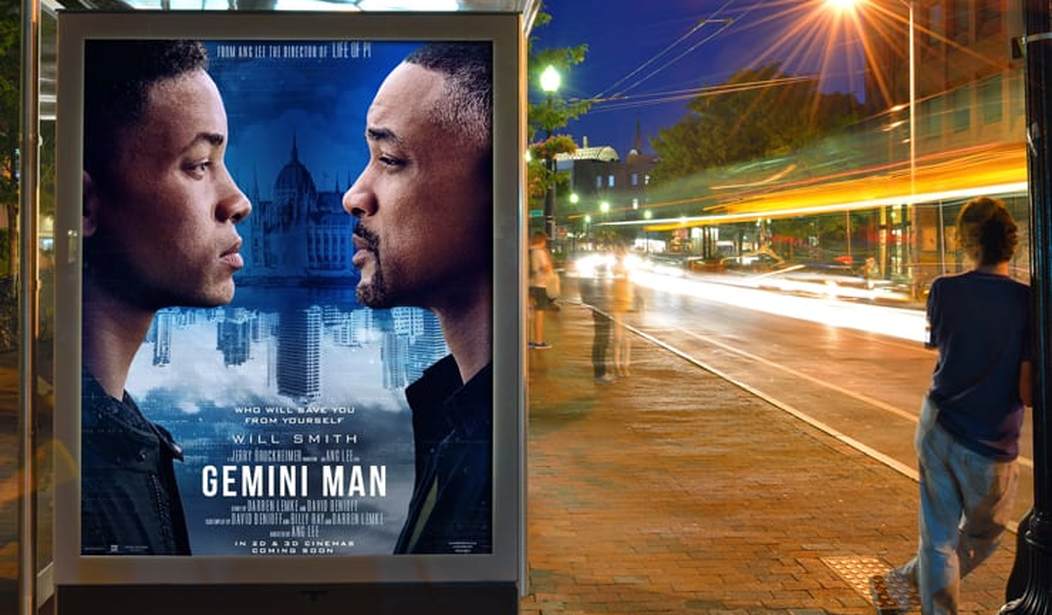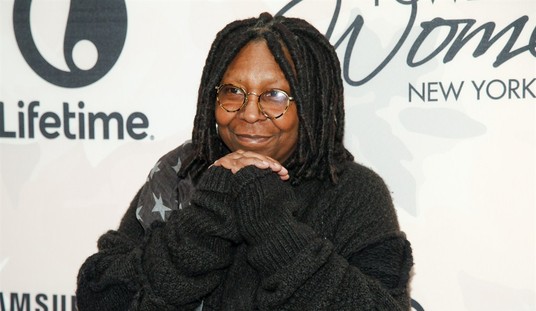In a recent article titled “Will Smith, Robert De Niro and the Rise of the All-Digital Actor,” the Hollywood Reporter spots the latest special effects trend. Old and busted? Digital spaceships. The new hotness? Digital thespians:
This fall, two prestige tentpoles will test the waters for this new paradigm. In Paramount’s Ang Lee-helmed Gemini Man (Oct. 11), “Junior” Smith involved creating a fully digital character that looks and acts like Smith did around 1996 when he starred in Independence Day. The character was created by VFX house Weta Digital to use in some of the most complex scenes where “Junior” has to act alongside Smith.
Meanwhile, Martin Scorsese’s period drama The Irishman stars Robert De Niro, 75, as Frank Sheeran, a labor union leader and alleged hit man for the Bufalino crime family, and Al Pacino, 79, as union activist Jimmy Hoffa. Both actors (and others) will appear at different ages spanning decades, which is accomplished with VFX and makeup.
But it’s the digital de-aging work, which is being handled by Lucasfilm’s Industrial Light & Magic, that has been the focus of much curiosity, though specifics of the techniques used haven’t been revealed. It’s become common for an actor to have their face and body scanned at the start of a project if VFX might be needed (for instance, in action films for a digital stunt double).
A believable, fully digital human is still considered among the most difficult tasks in visual effects. “Digital humans are still very hard, but it’s not unachievable. You only see that level of success at the top-level companies,” explains Chris Nichols, a director at Chaos Group Labs and key member of the Digital Human League, a research and development group. He adds that this approach can be “extraordinarily expensive. It involves teams of people and months of work, research and development and a lot of revisions. They can look excellent if you involve the right talent.”
That was certainly true in the Star Wars “prequel,” Rogue One, as I wrote in December of 2016:
While the expected interstellar battles are vividly depicted onscreen in Rogue One, at his main perch at the New York Post, [Kyle] Smith noted that the real special-effects triumph of the film is bringing Peter Cushing back to life as Grand Moff Tarkin, in one of Rogue One’s best performances. (Shades of how the computer-generated Jar Jar Binks stole Episode One for better or worse by being a far more human character than the way his flesh-and-blood counterparts were directed by Lucas.) A young Princess Leia also makes a cameo appearance, and curiously, looks far more waxworks than Tarkin. Perhaps Peter Cushing’s wrinkled and craggy visage adds a texture that, when modeled with CGI, looks more realistic than a digital recreation of Carrie Fisher’s pearlescent skin at age 19.
More from Kyle Smith:
Casual viewers may not even notice, but one of the chief surprises in the movie is the unexpected reappearance of one of Darth Vader’s top officers, Grand Moff Tarkin, played by Peter Cushing. Cushing, who first appeared in 1977’s “Star Wars,” has lots of screen time, pages of dialogue and interactions with other actors such as Ben Mendelsohn, who plays fellow Imperial officer Orson Krennic.
Which is remarkable considering that Cushing died in 1994.
What you’re seeing is a digital performance, a visual effects (VFX) achievement that dazzles precisely because it’s seamless. This isn’t a cheesy, pasted-in effect that repurposes old footage, but a living, breathing, resurrected Cushing. The slender, 6-foot-4 British actor Guy Henry (he played Pius Thicknesse in the final Harry Potter films), who does bear a resemblance to the gaunt Cushing, was hired to play the role on set, in part to avoid the dead-eye effect that plagues simulations of actors. Then the VFX team magically transformed him into Cushing. “One of the best performances in ‘Rogue One’ is by an actor who died in 1994,” ran a headline in the Washington Post last week.
This, it turns out, is what the entire VFX industry has been building up to for all these decades. All those explosions and space chases were just the throat-clearing before the grand statement: Today they are bringing actors back from the dead. We always knew movie stars were gods. Now they’ve become immortal.
Smith’s piece from 2016 and the Hollywood Reporter article from earlier this month highlight that the digital technology to both de-age existing actors and recreate thespians who have gone off to the great backlot in the sky is making increasingly photo-realistic strides. Way back in 1986 though, Arthur C. Clarke saw it all coming, in a book that has the now rather timely name, Arthur C. Clarke’s July 20, 2019: Life in the 21st Century:
One aspect of the movies that won’t change in the next century is subject matter. There is no reason to believe that the traditional film genres won’t be as popular forty years from now as they were in the 1930s and 1940s. Love stories, science fiction, teenage comedies, war films, sweeping adventures, and rugged Westerns will be among the most successful movies of 2019. [On this, Clarke was slightly off; if only today’s Hollywood proffered that much variety. — Ed]
However, new technologies will make possible a different approach to the traditional themes. Computer-graphic techniques will enable producers to re-create electronically the voices and physical appearances of great movie stars from the past A new movie featuring a cast of Hollywood hall-of-famers — Jimmy Stewart, Greta Garbo, John Wayne, Marilyn Monroe — isn’t just possible, it is probable once computer synthesis techniques are perfected.
Computer graphics hold myriad implications for the movies of the twenty-first century. It will be more practical and cost effective to design sets and synthesize almost any location on Earth or off using computers. Special effects that now require models and miniatures can be replaced by digital picture-making. Animation, once the most visually exciting area of film, today has, except for an occasional Disney film, almost vanished. Computer graphics will cut the cost of animation in the next century, and cartoons featuring solid-looking, three-dimensional characters will breathe new life into this art form.
That last sentence neatly anticipates Pixar. But in terms of de-aging flesh-and-blood actors, or recreating deceased performers entirely from scratch, at the moment, there’s a slight lag between the technology to visually recreate an actor and recreating his voice. In Rogue One, Guy Henry, the actor who played Peter Cushing on the set, and whose face was replaced with zillions of dollars of digital effects, also supplied his voice, and did a pretty close approximation of Cushing’s clipped British accent. In order to bring Darth Vader back to life, the producers eschewed British bodybuilder David Prowse, who was inside the Vader suit and mask in 1977, but by the time Rogue One went before the cameras was over 80. However, James Earl Jones is happily still alive, and once again headed to his nearest recording studio to provide the menacing voice of everyone’s favorite Sith Lord. But at the time of production, Jones himself was 85, and anyone watching Rogue One followed by the original Star Wars will immediately notice the disparity between his voice in the two films, shot decades apart, but in movie time take place almost immediately back to back. But there’s no doubt that “de-aging” voice technology will eventually catch up to its visual equivalent. As for deceased actors, voice impersonators such Rich Little will likely be increasingly busy supplying the dialogue to go with the 21st-century’s synthetic thespians.
While Clarke got this prediction spot-on, in retrospect, his 1986 preview of 2019 has its faults — the book was badly illustrated, with plenty of camp looking stock photos that often seem more like they’re mocking their subject matter rather than illustrating it. Had Macmillan, Clarke’s publisher, hired Ralph McQuarrie, the former Boeing designer who became the conceptual artist who created the look of Star Wars, or Syd Mead, the car designer turned illustrator for films such as Blade Runner and 2010: The Year We Made Contact to supply visionary paintings to accompany Clarke’s surprisingly spot-on textual predictions of 21st-century technology, it would have made the perfect coffee table book for the 1986 Christmas retail season. And while Clarke, who in 1984 co-authored a book based on a series of emails between himself and 2010 director Peter Hyams, clearly understood the Internet, even he couldn’t have anticipated how social media would create an endless virtual warzone, locking Americans on the right and left into a Cold Civil War that’s always threatening to go hot. But in terms of technology, we shouldn’t be all that surprised that the man who invented the communications satellite in 1945 should have gotten 2019’s technology so right.
Now if only Hollywood could get its writing back to 1945 standards to give their 21st-century digital thespians something interesting to do.










Join the conversation as a VIP Member